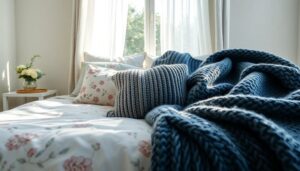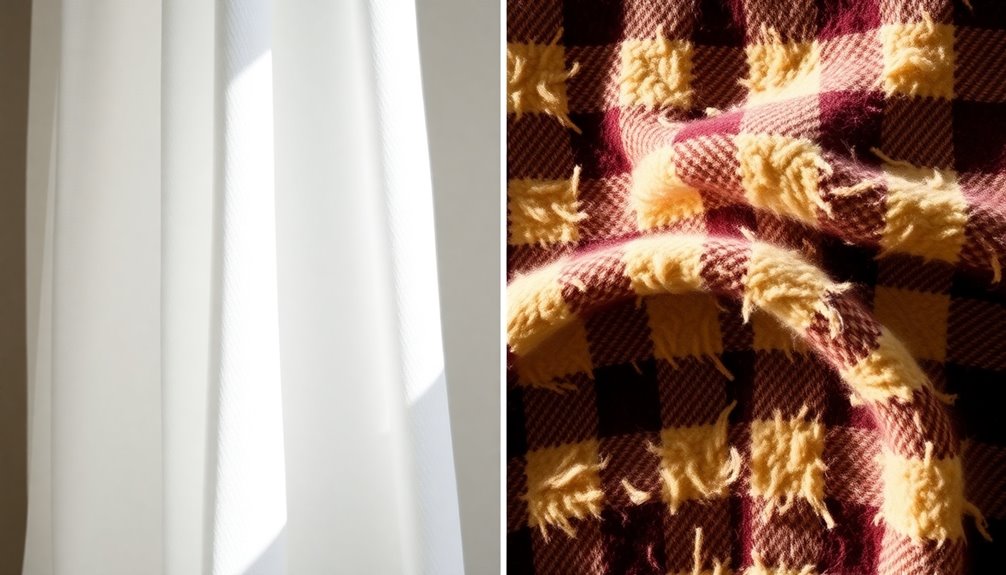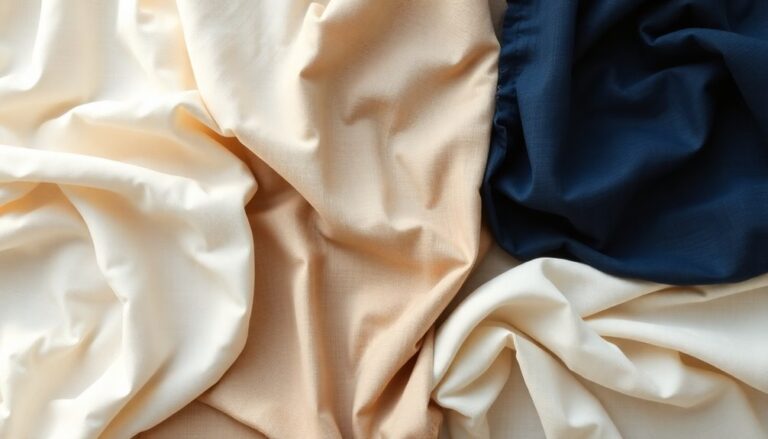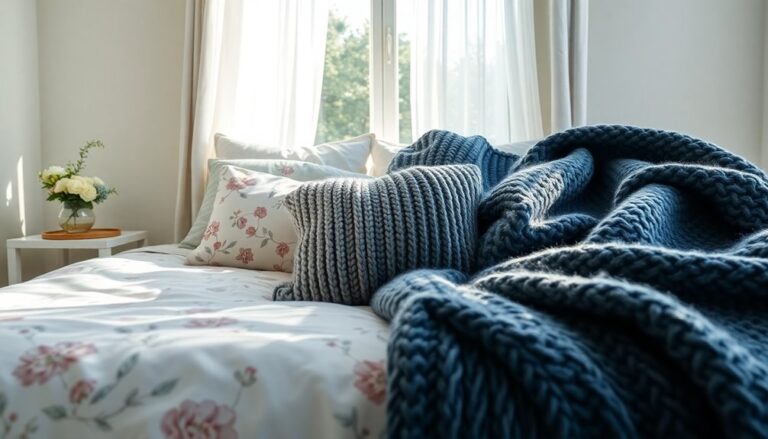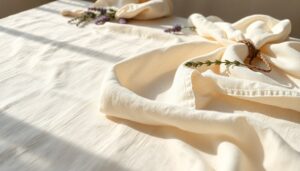Linen and flannel differ primarily in texture and temperature suitability. Linen is a smooth, breathable fabric ideal for warm climates, whereas flannel has a soft, brushed texture that provides warmth, making it perfect for colder weather. Linen withstands wrinkles better but can feel crisp, whereas flannel is cozy and versatile. Each fabric has its unique properties, uses, and care considerations, revealing more about their differences and applications in textiles when explored further.
Article Highlights
- Linen is a lightweight, breathable fabric best for warm climates, while flannel is thicker and warmer, ideal for colder weather.
- Flannel has a soft, brushed texture, whereas linen features a smooth and crisp texture.
- Linen is more prone to wrinkling, while flannel maintains its shape and is less wrinkle-resistant.
- Flannel is commonly used for cozy sleepwear and bedding, while linen is favored for summer clothing and home decor.
- Linen is environmentally friendly, requiring fewer resources to produce, while flannel is often made from cotton or synthetic fibers.
Overview of Linen

Linen, a timeless fabric, is renowned for its durability and breathability. Its history dates back thousands of years, with evidence of linen production found in ancient Egypt, where it was prized for its strength and ability to keep cool in hot climates. The production process involves harvesting flax plants, which are then spun into threads. This labor-intensive method results in a fabric that’s not just long-lasting but also environmentally friendly, as flax requires fewer pesticides and water compared to other crops. Over the centuries, linen’s versatility has made it popular for everything from clothing to home textiles. Today, it remains a preferred choice for many, appreciated for its classic appeal and natural qualities that improve comfort and style. Flax linen history showcases its enduring significance in both fashion and home decor, with artisans and designers continually finding new ways to incorporate it into modern trends. Its natural texture and ability to soften over time make it a favorite for those seeking both luxury and sustainability. As consumers become more environmentally conscious, linen’s appeal continues to grow, reinforcing its status as a timeless and eco-friendly fabric choice.
Overview of Flannel
Flannel, often associated with warmth and comfort, is a soft fabric traditionally made from wool, cotton, or synthetic fibers. Its origins date back to the 17th century in Wales, where it was first crafted from carded wool. Today, flannel is popular for its cozy feel and diverse designs, showcasing various flannel patterns.
- Available in solids, plaids, and checks
- Commonly used for shirts, sheets, and blankets
- Easy to care for and durable
- Provides excellent insulation and breathability
- Versatile for both casual and formal wear
With its rich history and practicality, flannel remains a beloved choice for those seeking comfort in their clothing and home textiles.
Key Properties of Linen
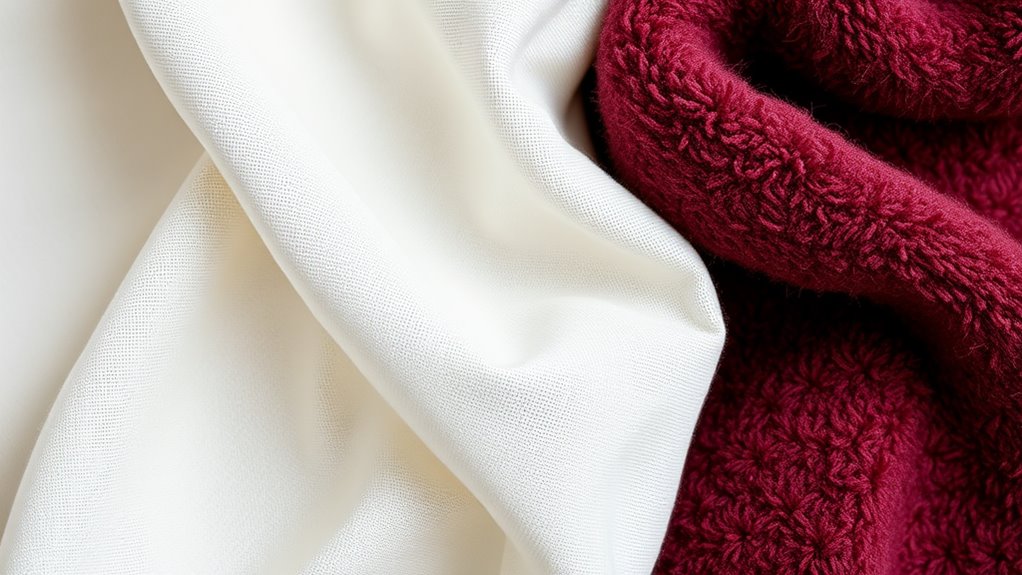
Linen is known for its remarkable breathability and moisture control, making it a popular choice in warm climates. Its durability and strength set it apart from many other fabrics, ensuring longevity in wear. Furthermore, the natural texture and feel of linen contribute to its appeal, providing comfort without sacrificing style.
Breathability and Moisture Control
One of the standout features of linen is its exceptional breathability and moisture control. This natural fiber is known for its impressive moisture management, making it a favorite for warm climates. Its unique airflow characteristics allow it to wick moisture away from the body, keeping individuals cool and comfortable.
Some key benefits of linen include:
- High airflow, promoting ventilation
- Natural moisture-wicking properties
- Quick drying, ideal for humid environments
- Temperature regulation, adapting to body heat
- Softening with each wash, enhancing comfort
Due to these properties, linen is an excellent choice for bedding and clothing, especially during the hotter months. Its ability to maintain a balanced microclimate makes it a preferred option for those seeking comfort and freshness.
Durability and Strength
Even though many fabrics may wear down over time, linen stands out for its impressive durability and strength. When considering a longevity comparison with other materials, linen often outperforms because of its natural fibers, which are inherently resilient. This durability means that linen can withstand frequent use and washing without losing its integrity. In strength evaluation, linen's fibers are stronger than cotton, making it less prone to tearing or fraying. These qualities make linen an excellent choice for items subjected to wear and tear, such as tablecloths and bed linens. Overall, those seeking long-lasting fabric options will find that linen not merely meets but often exceeds expectations regarding durability and strength.
Natural Texture and Feel
When considering fabric choices, the natural texture and feel of linen often captivate those who appreciate comfort and style. Its unique properties make it a popular option for various applications.
- Natural softness: Linen offers a gentle touch that feels great against the skin.
- Breathability: The fabric allows air circulation, keeping wearers cool in warm weather.
- Moisture-wicking: Linen absorbs moisture without feeling damp, adding to its comfort.
- Texture comparison: Unlike flannel's fuzzy surface, linen has a crisp, textured finish that provides a distinct aesthetic.
- Aging gracefully: With time, linen develops a beautiful patina, enhancing its charm.
Key Properties of Flannel
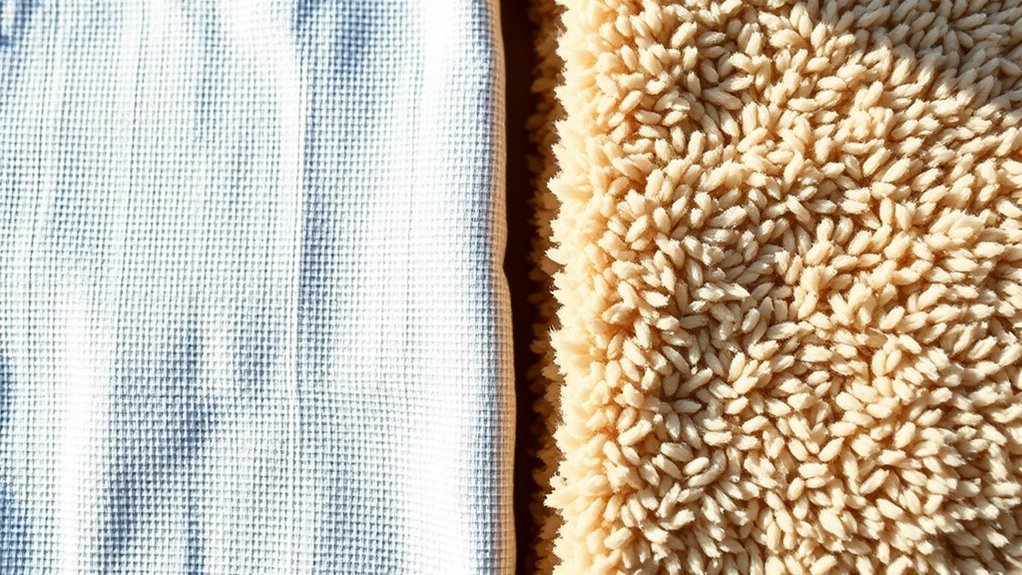
When exploring flannel, it's important to understand its unique fabric composition and the warmth it provides. This soft material is known for its excellent insulation properties, making it a popular choice for colder climates. Furthermore, proper care and maintenance can extend the life of flannel garments, ensuring they remain cozy and functional.
Fabric Composition Overview
Flannel, a cozy fabric often associated with warmth and comfort, is primarily made from cotton, wool, or synthetic fibers. These fabric types contribute to its soft texture and versatility in various textile applications.
Key properties of flannel include:
- Softness: Gentle against the skin, making it a favorite for sleepwear and bedding.
- Breathability: Allows for airflow, preventing overheating during use.
- Durability: Resistant to wear and tear, suitable for everyday use.
- Absorbency: Effectively wicks moisture, keeping wearers dry.
- Versatility: Available in various weights and patterns, perfect for diverse projects.
These characteristics make flannel a popular choice for everything from cozy shirts to comfortable sheets, appealing to those who prioritize comfort and functionality.
Warmth and Insulation
Although many fabrics offer comfort, flannel stands out for its exceptional warmth and insulation properties. This fabric is designed using various insulation methods, making it ideal for colder climates. Flannel's unique brushed texture creates air pockets, which trap heat and provide a cozy experience. In warmth comparison with linen, flannel retains heat more effectively, making it a preferred choice for winter apparel and bedding. While linen is breathable and cool, it lacks the thermal qualities flannel offers. Those seeking warmth in their clothing or home textiles often gravitate toward flannel, as it combines softness with substantial insulation. In the end, flannel's ability to keep individuals warm sets it apart in the fabric industry.
Care and Maintenance Tips
To maintain the softness and longevity of flannel, proper care and maintenance are essential. This fabric requires specific washing techniques and storage recommendations to guarantee it stays in top condition. Here are some tips to help care for flannel:
- Wash in cold water to prevent shrinking.
- Use a gentle detergent to protect the fibers.
- Avoid bleach, as it can damage the fabric's texture.
- Tumble dry on low heat or air dry to keep flannel fluffy.
- Store flannel items in a cool, dry place, away from direct sunlight.
Best Uses for Linen
Linen, known for its breathability and durability, shines in various applications, making it a popular choice for many. One of its best uses is in summer clothing. The lightweight fabric allows for airflow, keeping wearers cool and comfortable during hot weather. From casual dresses to stylish shirts, linen's natural texture adds an effortless elegance to summer wardrobes.
Moreover, linen is an excellent option for home decor. Its timeless appeal and ability to drape beautifully make it ideal for curtains, table linens, and upholstery. Linen's natural fibers likewise lend a relaxed, airy feel to any space, enhancing the overall ambiance. Whether for fashion or home, linen's versatility guarantees it remains a favorite among those who appreciate quality and comfort.
Best Uses for Flannel
Flannel, with its soft and cozy texture, is a staple for colder seasons. People love using flannel for various applications that improve comfort and warmth. Here are some of the best uses for flannel:
- Cozy pajamas: Perfect for snuggling up on chilly nights.
- Rustic bedding: Adds a warm, inviting touch to bedrooms.
- Blankets: Great for wrapping up during cold evenings.
- Shirts: Ideal for layering, providing warmth without bulk.
- Craft projects: Versatile for making cushions, quilts, and more.
Whether it's for a cozy night in or adding charm to home decor, flannel proves to be a practical choice that combines functionality with style. Its versatility makes it a beloved fabric for many.
Frequently Asked Questions
Can Linen and Flannel Be Blended for Fabric?
It's interesting how many people wonder about the possibilities of fabric combinations. In terms of blending techniques, linen and flannel can certainly be combined. This unique blend can create a fabric that benefits from linen's breathability and flannel's softness. The result is a durable fabric that offers comfort as it maintains strength. This combination caters beautifully to those seeking style and practicality, making it a popular choice for various clothing and home textiles.
How Do Linen and Flannel Compare in Terms of Cost?
When considering the cost factors, a price comparison between linen and flannel reveals some differences. Linen, often regarded as a premium fabric, tends to be pricier because of its labor-intensive production process. Conversely, flannel, typically made from cotton or synthetic fibers, usually comes at a lower cost. Comprehending these aspects helps consumers decide based on their budget and fabric preference, ensuring they get value for their money.
What Are the Environmental Impacts of Linen and Flannel Production?
The environmental impacts of linen and flannel production vary considerably. Linen, derived from flax, often employs sustainable practices and has lower resource consumption, requiring less water and pesticides. Conversely, flannel, typically made from cotton or synthetic fibers, may involve more intensive farming methods, leading to higher resource consumption and environmental strain. Comprehending these differences helps consumers make informed choices about their textile purchases, promoting eco-friendly options that align with their values.
How Do Linen and Flannel Fabrics React to Washing and Drying?
Ah, the delicate dance of washing and drying fabrics—where linen and flannel engage in a battle of wills. Linen, with its notorious shrinkage tendencies, often shrinks like a timid flower in winter, whereas flannel's softer side may lead to color fading, leaving garments looking a bit lackluster. Each fabric, it seems, has its quirks: one aims for elegance, the other for comfort, but both require a gentle touch to maintain their charm.
Are There Specific Care Instructions for Linen and Flannel?
Regarding care tips for linen and flannel, proper fabric maintenance is crucial. Linen should be washed in cool water and air-dried to prevent shrinking. It's best to iron it when slightly damp. Flannel, conversely, can typically handle warmer water and should be tumble-dried on low heat. Both fabrics benefit from gentle detergents to maintain their quality, ensuring they last longer and stay comfortable.



